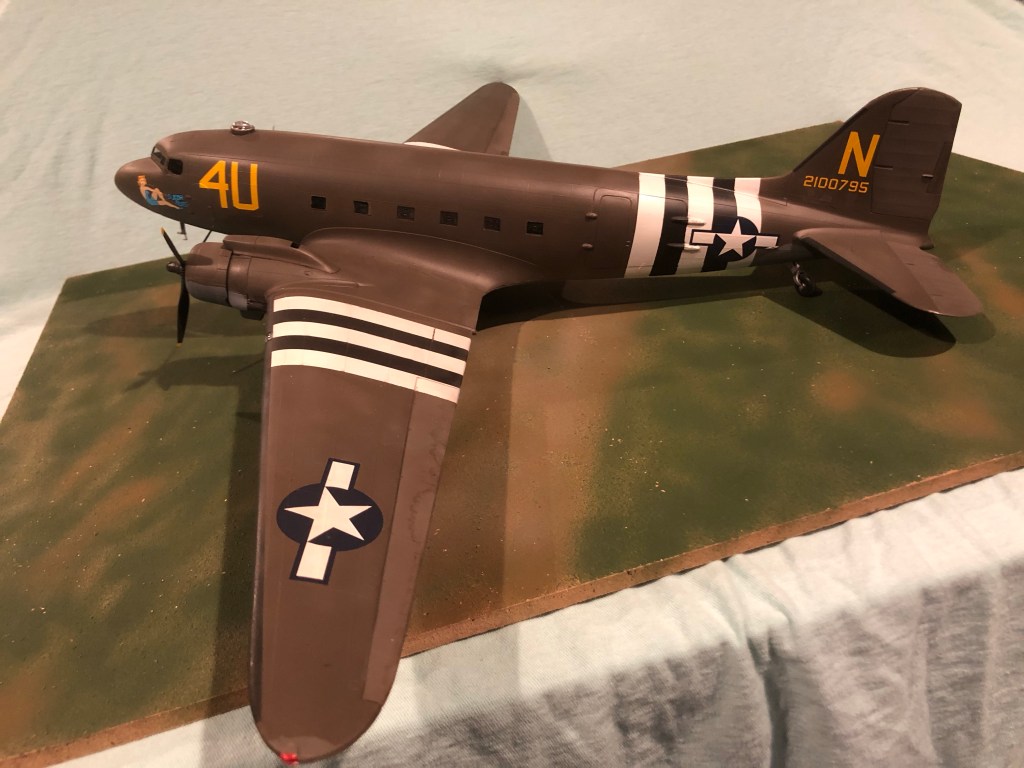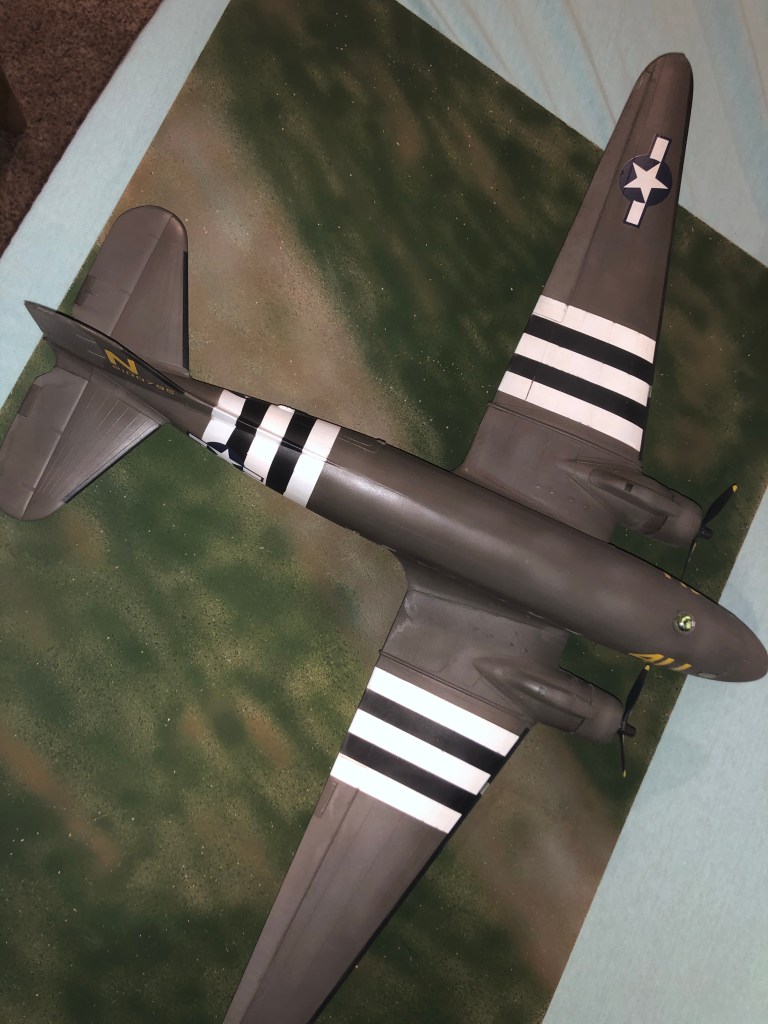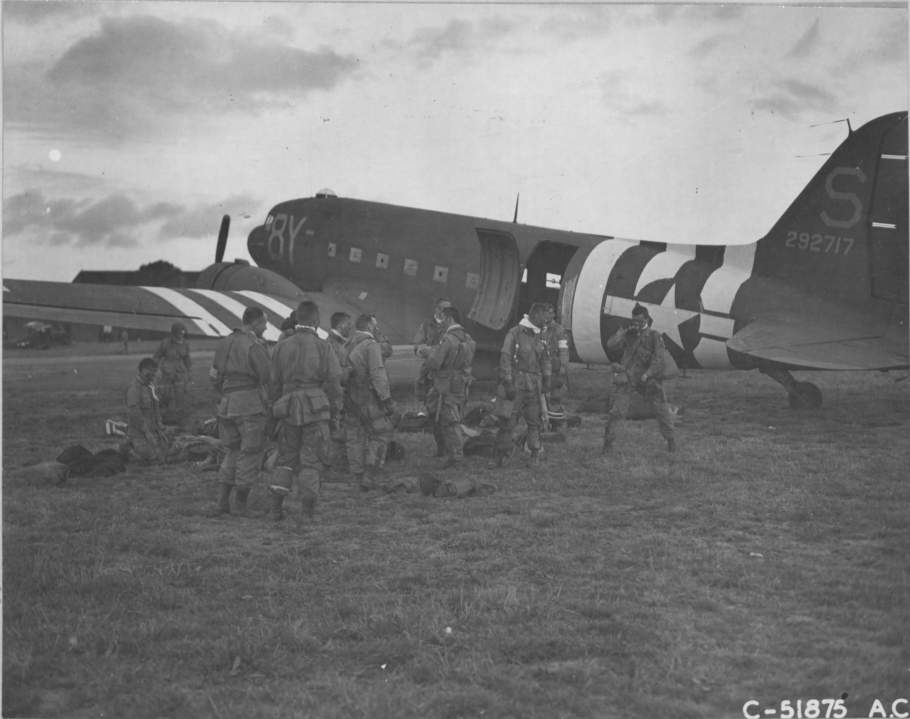Perhaps the most important type that didn’t carry guns or bombs.

Let’s take a look at a truly key aircraft.
Perhaps the very best known aircraft I hadn’t built yet, the C-47 was important as both a civil and military aircraft.

In 1933, a new and radically modern airliner first flew for United Airlines. It featured all metal (aluminum) construction, fully cantilevered wings, retractable landing gear, auto pilot and rubber de-icer boots. It was revolutionary and could change the airline industry. But Boeing owned United Airlines and refused to sell their Model 247 to any other company until all 60 aircraft of United’s order had been filled.
So TWA approached Douglass about making something similar, but of course, better. Douglass responded with the DC-1 that flew later in 1933. This was very promising start, good enough it entered airline service at the tail end of 1933 even though it was essentially a prototype. After a few tweaks the new design entered production the following year as the DC-2. With two R-1820 engines of 750 hp each the new type could carry 12 passengers. It also generated military interest and saw service as C-32, C-33,
C-34, R2D and several other designations! At this point the Army Air Force tended to assign a new number for every slight twist on a design.

Meanwhile American Airlines was looking for a new sleeper transport, an airliner with beds to replace their obsolete Curtiss Condor biplanes. This led to the DST, Douglass Sleeper Transport in 1935. The main improvement it offered over the DC-2 was a more spacious fuselage for side by side beds, but it also had bigger wings and more power. If looked at next to a DC-2 the two planes looked nearly identical except for the slightly bigger dimensions of the DST. Naturally after seven DSTs had been delivered American also ordered a 21 seat version of the plane that was labeled “DC-3”. The new plane could be ordered with either R-1820 Cyclone or R-1830 Twin Wasp engines.
The DC-3 also drew immediate military interest. It was ordered as “C-47” by the Army Air Force and “R4D” by the Navy. The military version used the R-1830 engine, had a strengthened floor, an astrodome for celestial navigation (right behind the cockpit) and a multi-function main door for passengers or cargo. With the coming of War some 400 civilian DC-3s were taken over by the military as C-53 Skytroopers; plus several already built aircraft were taken over by the military under a variety of number/designations.

It saw extensive use during the War years. Perhaps its key role was keeping supplies flowing to allied units of all sort wherever they found themselves. As early as the Guadalcanal Campaign it proved to be a difference maker both for bringing supplies in and getting sick and wounded out. It also was the cornerstone of a lifeline over the Himalayas that kept China in the War against Japan.
But perhaps the C-47 was best known for its role in dropping paratroopers behind enemy lines. From North Africa to Sicily and Italy, to the big operations of Overlord, Market Garden and Varsity. This is one of the most enduring images of the War, even if routine cargo runs always took most of their time. And it was this combination of roles that led to Dwight Eisenhower labeling it as one of the five most important weapons of World War II.

This particular aircraft belongs to the 89th Troop Carrier Squadron, 438th Troop Carrier Group, 9th Air Force. The Group was based in England (Greenham Common) through 1944 and moved to France (Prosnes) in February, 1945.
On the night of June 5, 1944 they dropped the 101st Airborne Division’s 502nd Parachute Infantry Regiment into Carentan. Part of the 89th TCS was briefly moved to Italy in August 1944 to help with paratrooper drops during Operation Dragoon, the invasion of Southern France. Then with everyone back in England they dropped troops in Operation Market Garden in September. In December they were dropping supplies to the 101st Airborne in Bastogne. Then, after moving to France, they participated in the big drop of Varsity to get troops across the Rhine.

This is the Monogram kit with Eagle Strike decals. It was not a hard build, with a few qualifications. This is the last of Monogram’s BIG kits that I hadn’t previously built. I acquired it very used, with a waterlogged box and ruined decals (that I wasn’t planning on using anyway). I have a couple more of this kit in prettier boxes, but this one got built first because it wouldn’t stack well with others! I think I paid $8 for it, like it was 1975 all over again. Having no weapons or ordnance it is a simpler kit than the other big aircraft were. But it does come with a bunch of paratroopers, so I will definitely build another to show a boarding scene. Initially I was very enthusiastic about how well it was fitting together, but the wing/fuselage seam proved to be brutal! Just when I was getting optimistic about things! One funny glitch, this plane has a full lavatory in the rear. Bombers often have a chemical toilet somewhere back there, but as a former airliner this one even has a sink. How civilized! So I painted and assembled it all (not hard; just, its there) only to notice when gluing the fuselage halves together that there is absolutely no way to see it! I mean who really wants windows in the can anyway, right? Maybe on a later build I’ll photograph the whole interior before gluing it up. But when cleaning up the seam I heard the unmistakable sound of something breaking loose. I’m sure it was the sink, its position was precarious anyway. I wasn’t about the break things back open to fix something so completely hidden, but for the next three weeks I got to listen to the lovely sound of loose plastic rattling around every time I touched it. Let’s call it a “feature”. No one will ever know unless they’re touching something they shouldn’t! Or, er, I tell them…

Some 15000 of all variants were produced by Douglass in the US, another 5000+ were built under license as “Li-2” in the Soviet Union and 500 more in Japan (Showa L2D, Allied code name Tabby).
Post-War the type remained in service around the world. It remained in its original role right up to current day, even though major users considered it obsolete even before the end of World War II with the newer DC-4/C-54 entering service. Its also been modified in numerous ways, and seems likely to continue flying for many years to come.



I built one!
Cool! Do remember the plane?
One of the designs they got right, they’ll still be flying long after we’re gone. Surprising how big they are, they’re only slightly smaller than a B-17.
Yeah the size really struck me, very big for a twin!
But as you say, they got it all right. Rugged, functional and good looking!
It is certainly iconic! Perhaps one of the worlds best known aircraft it’s up three with all the greats of World War 2.
Definitely one of the best known types, and easily the best known transport.
In 1982 the Chevrolet Camaro claimed a very low coefficient of friction (Cd) of .36. The DC3 Cd is .16! Going by memory here.
I did not realize it was so slippery!